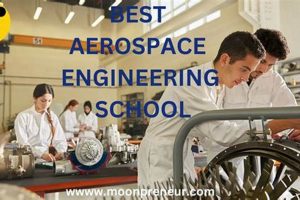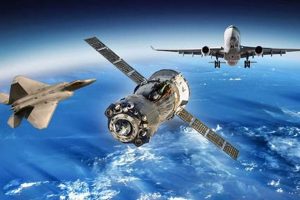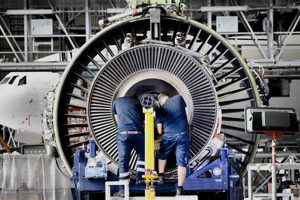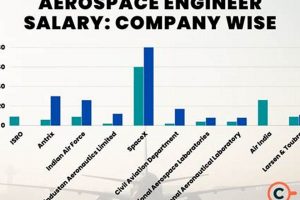The integration of computational principles and methods within the design, development, and operation of aircraft and spacecraft is a specialized area. This field encompasses a broad range of activities, from the creation of embedded systems controlling flight surfaces to the development of sophisticated simulation software used in aerodynamic testing. As an illustration, consider the software responsible for autonomously piloting unmanned aerial vehicles or the complex control systems managing the stability of a commercial airliner. These exemplify the practical applications within this domain.
Its significance stems from its pivotal role in enhancing safety, improving efficiency, and enabling innovation within the aeronautical and astronautical sectors. Historically, advances in computational power have directly correlated with breakthroughs in aircraft design and space exploration. The capacity to model complex physical phenomena computationally, coupled with the ability to implement real-time control systems, has been instrumental in achieving unprecedented levels of performance and reliability. This domain also facilitates cost reduction through virtual prototyping and automated testing methodologies.
The subsequent sections will delve into specific facets of this multifaceted discipline. These will cover topics such as the design and implementation of flight control systems, the application of artificial intelligence in autonomous navigation, and the challenges of developing fault-tolerant architectures for critical aerospace applications. The integration of cybersecurity principles and techniques within these systems to ensure system security and data integrity will also be discussed, offering a detailed overview of the technical considerations within this realm.
Guidance for Aspiring Professionals
This section provides targeted advice for individuals pursuing careers at the intersection of computation and flight/spacecraft technologies. The following points emphasize critical skills and areas of focus.
Tip 1: Solidify Foundational Knowledge: A comprehensive understanding of computer science principles, including data structures, algorithms, and operating systems, is paramount. This knowledge serves as the basis for developing robust and efficient aerospace systems.
Tip 2: Master Relevant Programming Languages: Proficiency in languages such as C, C++, Python, and Ada is often required. C and C++ are frequently used in embedded systems development, while Python is prevalent in data analysis and simulation.
Tip 3: Cultivate Embedded Systems Expertise: Aerospace systems heavily rely on embedded systems. Develop expertise in microcontroller programming, real-time operating systems (RTOS), and hardware-software integration.
Tip 4: Prioritize Control Systems Knowledge: Understanding control theory, feedback systems, and signal processing is essential for designing stable and responsive flight control systems. Linear algebra is a must.
Tip 5: Explore Simulation and Modeling Tools: Familiarize with software such as MATLAB/Simulink, ANSYS, and computational fluid dynamics (CFD) packages. These tools are critical for system design, analysis, and validation.
Tip 6: Acquire Knowledge of Aerospace Standards: Familiarity with industry standards such as DO-178C (software) and ARP4754A (systems) is crucial for developing safe and reliable airborne systems. These standards impose rigorous processes and documentation requirements.
Tip 7: Emphasize Cybersecurity Awareness: As aerospace systems become increasingly interconnected, cybersecurity becomes a critical concern. Understanding security vulnerabilities and implementing robust security measures is essential.
Tip 8: Focus on Fault Tolerance and Reliability: Aerospace systems must be designed to operate reliably in harsh environments. Gain experience in designing fault-tolerant architectures and implementing redundancy strategies.
By focusing on these key areas, prospective professionals can significantly enhance their preparedness for the challenges and rewards of contributing to the advancement within computation and flight/spacecraft technologies. The ongoing development of these skills and expertise will be vital for adapting to emerging technologies and maintaining a competitive edge.
The following sections will present a discussion of the future landscape of this intersection, considering emerging trends and ongoing research efforts.
1. Embedded Systems
Embedded systems form a critical and indispensable component within computational aspects of aerospace. These specialized computer systems are designed to perform dedicated functions within larger mechanical or electrical systems found in aircraft, spacecraft, and related equipment. The proper functioning of many aeronautical and astronautical operations is directly dependent on the reliability and accuracy of these embedded systems. This dependence stems from the fact that these systems are responsible for tasks ranging from basic control functions to complex calculations critical for flight stability and trajectory management.
The importance of embedded systems is highlighted by considering their deployment in various aerospace applications. In modern commercial aircraft, embedded systems control flight surfaces such as ailerons, elevators, and rudders, ensuring precise and stable flight. In spacecraft, these systems manage critical functions like attitude control, orbital adjustments, and data acquisition from scientific instruments. Furthermore, embedded systems are integral to engine management systems, optimizing fuel efficiency and reducing emissions. The design and implementation of these systems demand rigorous attention to detail, adherence to stringent safety standards, and the use of specialized development methodologies. The failure of an embedded system can have catastrophic consequences, underscoring the practical significance of ensuring their robustness and reliability.
In summary, embedded systems are foundational for the computational aspects of aerospace, enabling the control, management, and monitoring of critical functions. Understanding the design principles, development processes, and operational requirements of these systems is essential for computer engineers working in the aeronautical and astronautical sectors. This expertise ensures the continued advancement and safety of modern air and space travel.
2. Flight Control
Flight control systems represent a critical application of computational expertise within the aerospace domain. These systems are responsible for maintaining aircraft stability, executing pilot commands, and ensuring safe and efficient flight. The intricate algorithms and sophisticated hardware that underpin these systems are a direct result of advancements in computational engineering. The increasing complexity of modern aircraft, including unmanned aerial vehicles and high-performance military jets, necessitates highly advanced flight control architectures. A fundamental understanding of control theory, embedded systems, and real-time computing is essential for developing these systems. The performance of a flight control system has direct implications for aircraft maneuverability, fuel efficiency, and pilot workload. For example, fly-by-wire systems, commonly found in modern airliners, rely on electronic signals and computer processing to translate pilot inputs into control surface movements, replacing traditional mechanical linkages. This enhancement allows for greater control precision and improved stability, but it also introduces significant computational challenges.
The design of flight control systems involves a multifaceted approach incorporating mathematical modeling, simulation, and extensive testing. Engineers utilize computational tools such as MATLAB/Simulink to create accurate representations of aircraft dynamics and simulate flight conditions. These simulations enable the identification of potential instabilities and the optimization of control parameters. Furthermore, flight control systems must be robust and fault-tolerant, capable of operating reliably in the presence of sensor failures or actuator malfunctions. Redundancy is a key design principle, with multiple sensors and actuators providing backup capabilities in case of component failure. In autonomous systems, flight control algorithms must be capable of handling unexpected events and adapting to changing environmental conditions without human intervention.
In conclusion, flight control systems are a quintessential example of the synergy between computer engineering and aerospace. The ability to design and implement these systems requires a deep understanding of both computational principles and aircraft dynamics. Challenges remain in developing flight control systems that are more robust, adaptive, and secure. Continued research and development in areas such as artificial intelligence and machine learning will further enhance the capabilities of flight control systems, leading to safer and more efficient air travel and space exploration.
Navigation systems are integral to the safe and efficient operation of aircraft and spacecraft, relying heavily on the principles and applications of computation to determine position, velocity, and orientation. These systems represent a critical intersection between computer engineering and aerospace, enabling autonomous navigation, precise trajectory control, and enhanced situational awareness.
- Inertial Navigation Systems (INS)
INS utilize accelerometers and gyroscopes to measure changes in an object’s velocity and orientation. These sensors provide data to sophisticated algorithms that calculate position and attitude without relying on external signals. The computational complexity lies in integrating sensor data, compensating for drift errors, and modeling the Earth’s gravitational field. Modern aircraft and spacecraft rely on INS for navigation, particularly in environments where GPS signals are unavailable or unreliable.
- Global Navigation Satellite Systems (GNSS)
GNSS, such as GPS, GLONASS, Galileo, and BeiDou, utilize a constellation of satellites to provide precise positioning information. Receivers on aircraft and spacecraft process signals from multiple satellites to calculate their location. The computation involves solving complex equations to determine range from each satellite and accounting for signal propagation delays. GNSS are essential for en-route navigation, landing approaches, and precision maneuvers.
- Sensor Fusion Techniques
Many modern navigation systems employ sensor fusion techniques to combine data from multiple sources, such as INS, GNSS, radar, and vision systems. By integrating data from complementary sensors, the system can achieve higher accuracy, reliability, and robustness. Algorithms such as Kalman filters are used to estimate the optimal state of the vehicle, combining the strengths of each sensor while mitigating their weaknesses. Sensor fusion is particularly important in autonomous systems and challenging operating environments.
- Autonomous Navigation Algorithms
Autonomous navigation systems require sophisticated algorithms to plan and execute trajectories without human intervention. These algorithms must consider factors such as obstacle avoidance, path optimization, and dynamic constraints. Computational techniques such as pathfinding algorithms, motion planning, and reinforcement learning are used to develop autonomous navigation capabilities. The increasing demand for unmanned aerial vehicles and autonomous spacecraft is driving innovation in this area.
In conclusion, navigation systems exemplify the critical role of computer engineering in modern aerospace. These systems rely on a combination of sophisticated hardware, advanced algorithms, and real-time processing to provide accurate and reliable navigation capabilities. Ongoing advancements in sensor technology, computational power, and algorithm design will continue to enhance the performance and autonomy of aerospace navigation systems.
4. Simulation Software
The development and application of simulation software are intrinsically linked to computational expertise within the aerospace sector. Its employment allows for the virtual modeling and analysis of aircraft, spacecraft, and their associated systems. The software enables engineers to predict performance, identify potential design flaws, and optimize system behavior before physical prototypes are constructed. This process is not only cost-effective but also critical for ensuring the safety and reliability of complex aerospace vehicles. For instance, computational fluid dynamics (CFD) software simulates airflow around an aircraft wing, allowing engineers to analyze lift, drag, and stability characteristics without conducting expensive wind tunnel tests. Similarly, finite element analysis (FEA) software models the structural integrity of a spacecraft component, ensuring it can withstand the extreme stresses of launch and orbital operations. These software tools provide essential insights into the behavior of complex systems, serving as a cornerstone of modern design and development practices.
The impact of simulation software extends beyond the design phase, playing a crucial role in training, operations, and maintenance. Flight simulators, for example, provide pilots with realistic training scenarios, allowing them to practice emergency procedures and hone their skills in a controlled environment. These simulators replicate the cockpit environment, aircraft dynamics, and external conditions with high fidelity. Furthermore, simulation software is utilized for mission planning, trajectory optimization, and real-time monitoring of spacecraft operations. Predictive maintenance algorithms, informed by simulation data, can anticipate potential equipment failures, minimizing downtime and maximizing operational efficiency. The ability to simulate a wide range of scenarios and operating conditions is invaluable for managing risk and ensuring mission success.
In conclusion, simulation software stands as an indispensable tool within computation-driven aerospace engineering, influencing nearly every aspect of vehicle design, testing, and operation. The continuous advancement of simulation technology, driven by increasing computational power and sophisticated algorithms, has led to more accurate and comprehensive models. However, challenges remain in validating simulation results with real-world data and developing models that can accurately capture complex physical phenomena. As aerospace systems become increasingly complex, the role of simulation software will only continue to grow, demanding a highly skilled workforce proficient in both software development and aerospace engineering principles.
5. Robotics
The intersection of robotics and aerospace manifests in a multitude of critical applications, where robotic systems enhance manufacturing, inspection, maintenance, and exploration capabilities within the aeronautical and astronautical sectors. These applications are fundamentally enabled by computer engineering, which provides the necessary computational infrastructure, control algorithms, and sensor integration techniques for autonomous or remotely operated robotic systems to function effectively. The incorporation of robotics in aerospace results in increased efficiency, improved safety, and the ability to perform tasks that are either too dangerous or physically impossible for human personnel.
The application of robotics ranges from automated assembly lines in aircraft manufacturing, where robots perform precise welding, drilling, and composite layup, to the deployment of robotic arms on the International Space Station for satellite repair and scientific experimentation. Unmanned aerial vehicles (UAVs) equipped with sophisticated sensor payloads are utilized for infrastructure inspection, environmental monitoring, and search-and-rescue operations. Furthermore, planetary rovers, such as those used on Mars, demonstrate the capacity of robotic systems to explore remote and hazardous environments, collecting data and conducting scientific research under autonomous control. These examples highlight the reliance on computational control systems, embedded programming, and sensor data processing all within the purview of computer engineering to ensure the reliable and effective operation of robotic platforms in aerospace applications.
In summary, the integration of robotics within the aerospace industry is predicated on the capabilities provided by computer engineering. The development and deployment of robotic systems in this field require a deep understanding of computational principles, control theory, and embedded systems design. The practical significance of this integration lies in its capacity to enhance productivity, improve safety, and extend the reach of human exploration into challenging environments. Future advancements in artificial intelligence, machine learning, and sensor technology promise to further expand the role of robotics in aerospace, demanding continued innovation in the computational tools and techniques that underpin these systems.
6. Cybersecurity
The increasing reliance on interconnected systems within the aeronautical and astronautical sectors has introduced significant cybersecurity vulnerabilities. Modern aircraft and spacecraft are controlled by complex computer networks, making them potential targets for malicious actors. A successful cyberattack could compromise flight control systems, navigation equipment, or critical communication channels, with potentially catastrophic consequences. The integration of computer engineering principles in aerospace systems, while enhancing performance and efficiency, simultaneously expands the attack surface that must be defended. Real-life examples, such as the reported attempts to compromise aircraft flight control systems via onboard Wi-Fi networks, demonstrate the tangible threat that cybersecurity poses to the industry. The practical significance of this understanding lies in the necessity to proactively design and implement robust security measures to protect against evolving cyber threats.
To mitigate these risks, computer engineers must prioritize security throughout the entire system lifecycle, from initial design to ongoing maintenance. This includes employing secure coding practices, implementing strong authentication mechanisms, and regularly patching vulnerabilities. Furthermore, proactive threat modeling and penetration testing are essential for identifying weaknesses and validating security controls. The development of intrusion detection and prevention systems tailored to the specific needs of aerospace systems is also crucial. These systems can monitor network traffic and system behavior, detecting and responding to anomalous activity in real-time. Moreover, close collaboration between computer engineers, cybersecurity experts, and regulatory agencies is necessary to establish and enforce industry-wide security standards.
In conclusion, cybersecurity is an indispensable component of computer engineering in aerospace. The potential impact of a successful cyberattack necessitates a proactive and comprehensive approach to security, incorporating robust design principles, rigorous testing methodologies, and continuous monitoring. Addressing the cybersecurity challenges inherent in interconnected aerospace systems is crucial for ensuring the safety, reliability, and resilience of air and space transportation. The ongoing evolution of cyber threats demands a sustained commitment to research, development, and education in the field of aerospace cybersecurity.
Frequently Asked Questions
This section addresses common inquiries regarding the application of computational principles within the design, development, and operation of aircraft and spacecraft. The following questions and answers aim to provide clarity on key aspects of this field.
Question 1: What fundamental skill sets are essential for success?
A strong foundation in computer science, including data structures, algorithms, and operating systems, is paramount. Proficiency in programming languages such as C, C++, and Python is highly recommended. Expertise in embedded systems, control theory, and simulation tools is also critical.
Question 2: How does this specialization contribute to aerospace safety?
This specialized knowledge contributes significantly to safety through the design and implementation of robust flight control systems, reliable navigation systems, and sophisticated simulation software. These systems are essential for preventing accidents and ensuring the safe operation of aircraft and spacecraft.
Question 3: What are the primary career paths within this field?
Potential career paths include roles in flight control systems design, navigation systems development, embedded systems engineering, simulation and modeling, robotics, and cybersecurity. Opportunities exist within aircraft manufacturers, spacecraft developers, research institutions, and government agencies.
Question 4: What is the significance of cybersecurity in aerospace?
Cybersecurity is critical due to the increasing reliance on interconnected systems within aircraft and spacecraft. Protecting these systems from cyberattacks is essential to prevent the compromise of flight control systems, navigation equipment, and communication channels, thereby ensuring safety and security.
Question 5: How does simulation software enhance aerospace engineering?
Simulation software allows engineers to virtually model and analyze aircraft and spacecraft, predict performance, identify design flaws, and optimize system behavior before physical prototypes are constructed. This reduces costs, accelerates development, and enhances safety.
Question 6: What is the role of robotics within aeronautical and astronautical domains?
Robotic systems enhance manufacturing, inspection, maintenance, and exploration capabilities. They can perform tasks that are too dangerous or physically impossible for humans, increasing efficiency and improving safety in various aerospace applications.
In summary, a combination of computational skills, aerospace knowledge, and adherence to rigorous safety standards is vital for individuals working at this intersection. The ongoing integration of these skills continues to drive innovation and enhance the reliability of air and space transportation.
The next section will present a case study illustrating the practical application of computational expertise in a specific aerospace project.
Conclusion
The preceding discussion has explored the multifaceted role of computer engineering in aerospace. From the design of robust flight control systems to the implementation of secure communication protocols, the discipline permeates all aspects of modern aeronautical and astronautical endeavors. The reliance on computational principles, embedded systems, and sophisticated algorithms is not merely an enhancement but a fundamental requirement for achieving increasingly ambitious goals in air and space exploration. As vehicles become more autonomous and interconnected, the demand for skilled computer engineers capable of addressing the unique challenges within this domain will only intensify.
The continued advancement hinges on rigorous education, adherence to safety-critical development practices, and a proactive approach to emerging threats such as cybersecurity vulnerabilities. The future of air and space travel depends on the dedication and expertise of those who can effectively bridge the gap between computational innovation and the demanding requirements of flight. It is imperative that investment in research and development within this critical area be sustained to ensure continued progress and maintain a competitive edge in the global aerospace landscape.







